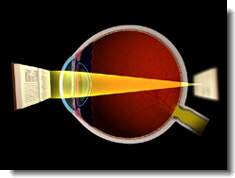
Farsightedness Or Hyperopia: What is it?
Symptoms You May Experience:
Examination: What Your Eye Doctor Will Look For:
What You Can Do:
When To Call Your M.D.:
Treatment:
Prognosis: Will I See Better?
Many infants are born farsighted but lose their farsightedness by the teenage years. Children and young adults with mild or moderate hyperopia are often able to see clearly because their natural lense can change its shape, or accommodate, to focus on near objects. As farsighted people get older, however, their ability to accommodate declines as the lens becomes less flexible. Eventually, glasses or contact lenses may be required to correct their farsightedness.
In adults, the vision is blurred at near but may be clearer at distance. You may notice eyestrain or fatigue, especially when reading. A farsighted child who is not wearing glasses or contact lenses may not notice any difficulty seeing up close because of accommodation, but in some farsighted children, eye crossing (strabismus) may occur.
The eye doctor will test your vision and your need for glasses (refraction). In children, the pupils may be dilated to relax accommodation before refraction is performed. Farsightedness is rarely diagnosed in school vision screenings, which typically only test the ability to see distant objects.
There is no proven way to prevent farsightedness from developing. You should be aware of its symptoms so if farsightedness develops, you can be examined by an eye doctor.
If you notice blurry vision close up but not at a distance, eye strain, or eye fatigue, you should call your eye doctor. Children should have an eye exam at least once by the age of six to diagnose any farsightedness or other eye problems.
Treating farsightedness depends on several factors, including your age and daily activities. Young patients may or may not require glasses or contact lenses, depending on their ability to compensate for their farsightedness with accommodation. Older patients often benefit from glasses or contacts, which may only be necessary for reading if their farsightedness is mild. Some farsighted adults may benefit from refractive surgery (laser eye surgery) as another treatment option.
Farsightedness, or hyperopia, is a condition in which distant objects are usually seen clearly but close objects are blurred. Just as a camera uses lenses to properly focus light on film, the human eye uses the cornea and the lens to focus images on the retina. In farsightedness, the image that falls on the retina is blurred because the light entering the eye is focused behind the retina instead of directly on it. This condition is caused by a cornea that is flatter than normal, a lens in the eye that is not strong enough, or an eyeball that is shorter than average. Approximately 25% of the general population is farsighted.

Contact Lenses | Glaucoma | Just For Fun | Eyeglasses | Eye Doctor | Eye Care And Symptoms | Eye Anatomy | Online Eye Tests | Laser Eye Surgery | Laser Eye Surgery Directory: Canada | Laser Eye Surgery Directory: USA | Laser Eye Surgery Reviews | Submit A Review | Contact Us | Privacy Policy | Sitemap
Copyright 2006-2009 Vision Health

